Commander Harry
Manning, former superintendent of the U.S. Maritime Service radio school
at Huntington, Long Island, is now skipper at Hoffman Island.
Commander Manning succeeded Commander M. E. Crossman who is
now head of the Alameda, Calif. station.
Trainees at Hoffman Island are
typical of those found throughout the service. There's Rudolph Maag of
Newark, N.J. who was a private in the Army at one time. He was working
in a threadmill before joining the Maritime Service. His buddy, Roland
Ouellettee, of Leominster, Mass., spent a year in the Navy and
is now training for another sea job with a different fleet. He was working
in a Pratt-Whitney plant before entering boot training at Hoffman Island.
The reason Roy Moon, a smooth-faced lad of 20 who hails from Spout
Spring, Va., entered the service was to "learn something about
engines so I'll have something to fall back on when the war's over."
Welfare Program
The "all work and no play" axiom holds just as true at a training
station as any other place, and the trainees at Hoffman Island are well
taken care of in their free hours. The welfare program is handled by Lieut.
Benny Leonard, former lightweight champion of the world, and includes
activities for the men every night of the week.
Boxing shows are very popular
at the base as well as boat races, basketball and other athletic events.
There are also radio broadcasts from the station, free movies and USO shows,
parties, and in good weather, all-station picnics. "We've never had
any difficulty with unorderliness, misconduct or AWOLs at any of our off-the-station
affairs," one station official said. "The fellows appreciate the
entertainment and don't have to fall all over themselves to have a good
time."
Full proof that trainees don't
expect to be handled softly is their eagerness to go through a lifeboat
drill that is carried out under sea conditions. The men jam the boat to
capacity and are sent out in the harbor at 2200 --- and stay out all night.
The boat isn't allowed to dock until 0600 the next day. If the weather is
rough, so much the better if a few of the boys get seasick, that's just
tough luck. The men, rather than resenting the ordeal, are glad to get the
experience.
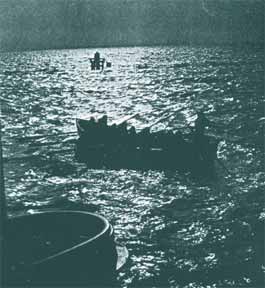
All night Lifeboat "cruise" in New York Harbor
The debatable honor system has
also succeeded magnificently. In a year and a half only two men have enjoyed
the ignominious role of occupying a seat in the brig. With this tradition
established, it is a moral obligation for all trainees to keep their respective
noses clean at all times. There is a further incentive to do good work here.
Scholastic awards are given men with the highest marks in the Deck, Engine
and Steward departments. Deck and Engine honor students get a set of books,
while the leading cook is presented a handsome set of knives. All three
receive, in addition, a letter of recommendation from the station superintendent.
The proficiency of the training
program is well exemplified by the ranks men receive upon graduation. It
is a rare day when an Engine student finishes up his work with any-thing
lower than an Oiler's ticket. And practically all of the Steward trainees
rate Cook and Baker papers. A carpenters school is held in connection with
Deck training and there are courses for prospective Able-Bodied Seamen who
have had sea time.
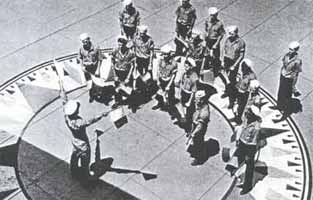
Signal practice for Maritime Service trainees |
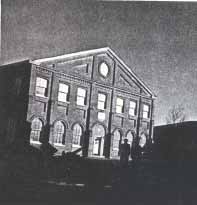
Former Quarantine building |
Hoffman Island also holds the
distinction of being a Maritime Service "guinea pig." It was the
first station to give its men classes in night lookout work and about two
years ago a number of Dutch soldiers received gunnery training on the island.
The latest innovation was the instigation of a new educational program for
officers and enlisted men of the Maritime Service who are going into administrative
work.
Every bit of the island is an
exemplification of life at sea. Because of its detachment from shore, the
base must be a self-sufficient unit. For example, diving equipment is used
to make dock repairs despite the absence of a professional diver. Even the
structure of the island resembles a vessel and trainees have an opportunity
to observe every ship that enters and leaves New York harbor.
Hoffman Island is part of
the defense system of New York, with its personnel responsible for manning
a battery of guns at one end of the base. An U. S. Army detachment is also
located there.
 All
training stations are not without their personalities, but at Hoffman Island
the No. 1 figure is not a well-known athletic figure or movie star. She's
Mitzi, the bulldog mascot, [seen at left] who is as independent
as a big-league baseball player during the winter season with an unsigned
contract. Mitzi is a "democratic pooch" and would just as soon
snub the station superintendent as she would a boot. However, she does prefer
the officer's mess.
All
training stations are not without their personalities, but at Hoffman Island
the No. 1 figure is not a well-known athletic figure or movie star. She's
Mitzi, the bulldog mascot, [seen at left] who is as independent
as a big-league baseball player during the winter season with an unsigned
contract. Mitzi is a "democratic pooch" and would just as soon
snub the station superintendent as she would a boot. However, she does prefer
the officer's mess.
Mitzi is not without her little
troubles, such as smashing into buildings and running off the end of docks
while chasing airplanes. She also has her feuds with Dopey Joe the Pigeon
who taunts the queen of the island with strafing attacks and then retires
to a branch nearby while Mitzi barks her lungs out.
Mitzi was promoted recently from
a Cox'n to Bos'n Mate and won 45 bucks in a world series pool last year.
She was once booted into the brig for biting a civilian.
Hoffman Island's history goes
back to 1872 when she was constructed by the City of New York to house a
quarantine station. The name was taken from Governor J. T. Hoffman and the
island handled the greatest immigration wave in our country's history before
it was abandoned and later used to store Navy equipment after the First
World War. It served as a harbor defense unit during that war in the same
manner it does today.
An outbreak of parrot fever along
the coast at one time turned Hoffman Island into an isolation station for
parrots instead of immigrants. In 1937 the island served still another purpose
when underprivileged children from New York were brought out every Sunday
throughout the summer for recreation.
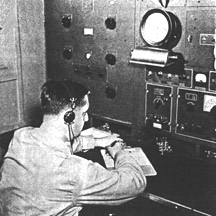 On
September 7, 1938, she went through another transformation. She became the
home for the first U. S. Maritime Service Training Station. The old quarantine
delousing plant became a boat shed, the largest and oldest of the quarantine
barracks was turned into a gymnasium and other buildings were made into
classrooms, barracks and mess halls.
On
September 7, 1938, she went through another transformation. She became the
home for the first U. S. Maritime Service Training Station. The old quarantine
delousing plant became a boat shed, the largest and oldest of the quarantine
barracks was turned into a gymnasium and other buildings were made into
classrooms, barracks and mess halls.
A new school building was constructed
in 1940 and a sick bay, additional barracks and a gun shed have been recently
put up. The entire base gives more the appearance of a cozy New England
town than a training station.
Three sailing ships have
been assigned to Hoffman Island, the latest being the 202-foot Vema,
which was built in Copenhagen in 1923. The Vema has a 33-foot beam and spreads
14,000 square feet of canvas. The Tusitala and Joseph Conrad
preceded the Vema as training ships for the island.
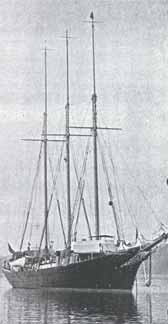
Training ship Vema |
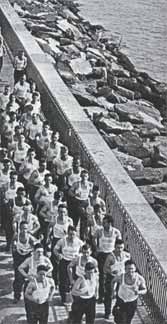
Morning run along sea wall |
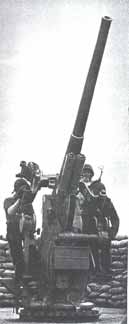
Guns used for harbor defense |
The first Apprentice Seamen who
appeared in the form of volunteers recruited from the nation's Civilian
Conservation Corps. Now they are drawn from all parts of the nation
to help win the war. For the duration, the course of training covers a period
of from three and six months, as the needs of the service require. It is
soon to add courses for the training of radio operators in conjunction with
the Gallup Island station.
Since its birth as a training
station more than five years ago, Hoffman Island has turned out seamen fully
equipped with the essential knowledge to take their places in the greatest
Merchant Marine the world has ever known. These men are not only equipped
with the tools of their trade, but with the kind of spirit that has carried
our merchant fleet through the most perilous days in its history.
Source:
Mast Magazine March 1944
United States Maritime Service
Home
7/27/03
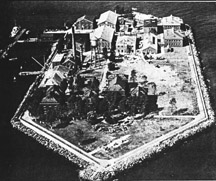
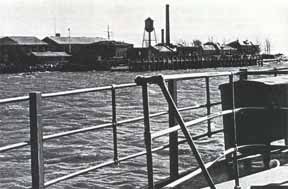
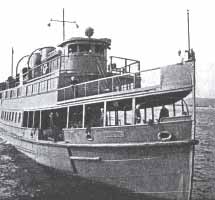
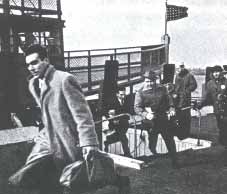
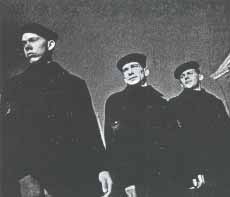
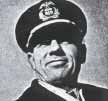
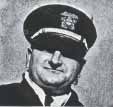
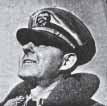



 All
training stations are not without their personalities, but at Hoffman Island
the No. 1 figure is not a well-known athletic figure or movie star. She's
Mitzi, the bulldog mascot, [seen at left] who is as independent
as a big-league baseball player during the winter season with an unsigned
contract. Mitzi is a "democratic pooch" and would just as soon
snub the station superintendent as she would a boot. However, she does prefer
the officer's mess.
All
training stations are not without their personalities, but at Hoffman Island
the No. 1 figure is not a well-known athletic figure or movie star. She's
Mitzi, the bulldog mascot, [seen at left] who is as independent
as a big-league baseball player during the winter season with an unsigned
contract. Mitzi is a "democratic pooch" and would just as soon
snub the station superintendent as she would a boot. However, she does prefer
the officer's mess. On
September 7, 1938, she went through another transformation. She became the
home for the first U. S. Maritime Service Training Station. The old quarantine
delousing plant became a boat shed, the largest and oldest of the quarantine
barracks was turned into a gymnasium and other buildings were made into
classrooms, barracks and mess halls.
On
September 7, 1938, she went through another transformation. She became the
home for the first U. S. Maritime Service Training Station. The old quarantine
delousing plant became a boat shed, the largest and oldest of the quarantine
barracks was turned into a gymnasium and other buildings were made into
classrooms, barracks and mess halls.

